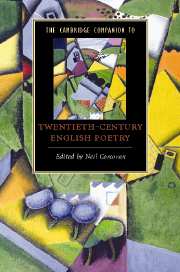Book contents
- Frontmatter
- Introduction
- Part I Contexts
- Part II Moderns
- Part III Modernists
- Part IV Later Modernities
- 10 Philip Larkin: a late modern poet
- 11 R. S. Thomas and modern Welsh poetry
- 12 Gender, feminism, poetry: Stevie Smith, Sylvia Plath, Jo Shapcott
- 13 Varieties of poetic sequence: Ted Hughes and Geoffrey Hill
- 14 Black British poetry and the translocal
- 15 Poetry and class: Tony Harrison, Peter Reading, Ken Smith, Sean O’Brien
- 16 A Scottish Renaissance: Edwin Morgan, Douglas Dunn, Liz Lochhead, Robert Crawford, Don Paterson, Kathleen Jamie
- 17 Lyric adaptations: James Fenton, Craig Raine, Christopher Reid, Simon Armitage, Carol Ann Duffy
- Index
10 - Philip Larkin: a late modern poet
from Part IV - Later Modernities
Published online by Cambridge University Press: 28 January 2008
- Frontmatter
- Introduction
- Part I Contexts
- Part II Moderns
- Part III Modernists
- Part IV Later Modernities
- 10 Philip Larkin: a late modern poet
- 11 R. S. Thomas and modern Welsh poetry
- 12 Gender, feminism, poetry: Stevie Smith, Sylvia Plath, Jo Shapcott
- 13 Varieties of poetic sequence: Ted Hughes and Geoffrey Hill
- 14 Black British poetry and the translocal
- 15 Poetry and class: Tony Harrison, Peter Reading, Ken Smith, Sean O’Brien
- 16 A Scottish Renaissance: Edwin Morgan, Douglas Dunn, Liz Lochhead, Robert Crawford, Don Paterson, Kathleen Jamie
- 17 Lyric adaptations: James Fenton, Craig Raine, Christopher Reid, Simon Armitage, Carol Ann Duffy
- Index
Summary
On 20 March 1942, aged nineteen, Philip Larkin wrote to his friend, Jim Sutton, excitedly announcing his admiration for D. H. Lawrence: 'I have been reading “Sons and Lovers” and feel ready to die. If Lawrence had been killed after writing that book he'd still be England's greatest novelist'. Larkin's own ambitions as a fiction writer came to fruition a few years later with Jill (1946) and A Girl in Winter (1947). The two novels suggest a full alertness to the range of Modernist experimentation in the writings of Lawrence and such contemporaries as Virginia Woolf and Katherine Mansfield. Modernist fiction of the first few decades of the twentieth century encouraged Larkin to move beyond realistic depiction into a symbolist evocation of a less tangible subject matter, including obscure dreams and desires. A similar trajectory can be found in the poetry from the 1940s onwards. The sudden shift from downbeat empiricism into visionary symbolism, an opening out from the securely known into the utterly unfathomable, was to become a hallmark of his work, giving a complex charge to many of his best-known poems, including 'The Whitsun Weddings' and 'High Windows'.
Larkin's enthusiasm for the fiction of Lawrence and Woolf might come as a surprise to those categorising his work as avowedly anti-modernist. An even greater surprise awaits anyone looking back to Larkin's earliest poems, since these show beyond doubt that the dominant influence was T. S. Eliot. 'The Ships at Mylae' is a free-verse composition, echoing The Waste Land, in which Larkin addresses his mock-hero in the peremptory manner with which Eliot summons the enigmatic Stetson: 'Stanley! / You who serene from unsung argosies / Gazed on the mounting foam!'
- Type
- Chapter
- Information
- The Cambridge Companion to Twentieth-Century English Poetry , pp. 147 - 158Publisher: Cambridge University PressPrint publication year: 2007
- 7
- Cited by

